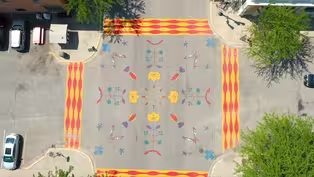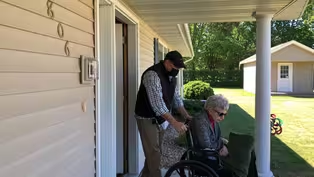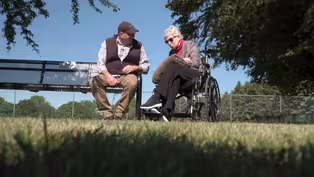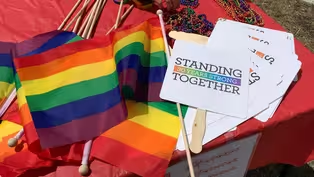Compass
August 2021 Edition
Season 5 Episode 11 | 26m 46sVideo has Closed Captions
Marshall's first Pride festival, respite care and creative crosswalks in Granite Falls.
Learn about Marshall's first Pride festival, hear a touching family story about respite care, see the creative crosswalks in Granite Falls and more!
Problems playing video? | Closed Captioning Feedback
Problems playing video? | Closed Captioning Feedback
Compass is a local public television program presented by Pioneer PBS
Compass
August 2021 Edition
Season 5 Episode 11 | 26m 46sVideo has Closed Captions
Learn about Marshall's first Pride festival, hear a touching family story about respite care, see the creative crosswalks in Granite Falls and more!
Problems playing video? | Closed Captioning Feedback
How to Watch Compass
Compass is available to stream on pbs.org and the free PBS App, available on iPhone, Apple TV, Android TV, Android smartphones, Amazon Fire TV, Amazon Fire Tablet, Roku, Samsung Smart TV, and Vizio.
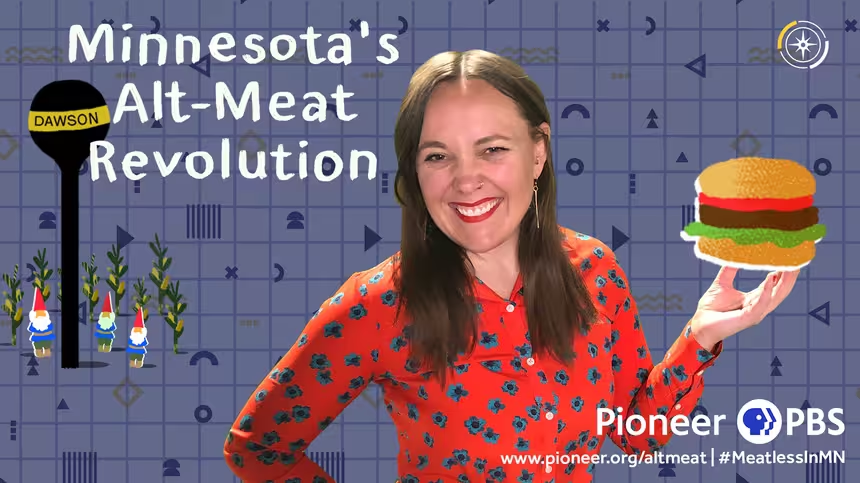
Minnesota’s Alt-Meat Revolution
“Minnesota’s Alt-Meat Revolution" is a year-long video and print journalism collaboration project, looking into the roots and impact of the plant-protein phenomenon that’s exploding across the globe.Providing Support for PBS.org
Learn Moreabout PBS online sponsorship- Funding for compass is provided in part by the Otto Bremer Trust.
The McKnight Foundation and members of Pioneer PBS.
Thank you.
Hi, I'm Amanda Anderson.
Welcome to the August edition of compass the regional public affairs show on Pioneer PBS.
Thanks to everyone who's been watching and engaging with our stories, both on air and online.
This refreshed version of compass is meant to be audience centered.
We also regularly post stories when they're completed on our website and social media.
Head over there to see what we've been working on and to comment and tell us what you think of each story as you watch.
First, in many cities pride has been celebrated for decades.
Now, Marshall Minnesota has added its name to the list of places holding an annual pride festival.
- The month of June marks pride month and communities all over the world are taking part in pride.
Marshall, Minnesota is no different.
They're hosting their first ever marshal pride.
(buoyant music) - My name is Julie Walker.
My pronouns are she/her mix and I'm the director of the LGBTQ+ center at Southwest Minnesota State University and I'm one of the organizers for pride this year.
So grateful.
It's good to be here.
All of you.
So give yourselves a hand (Applause) - I've lived in Marshall for about eight years and I'm absolutely thrilled that I get to be here with this community today.
(buoyant music) - Pride for me has always been some place where I just get to feel like myself.
The first time I went to pride, I balled like a little baby because for the first time I didn't have to think about how to behave.
I could just be me.
(buoyant music) - Many of the people that I'm associated with that are retired, have not had any experience very limited experience with diversity of any type and so activities like this help people to understand and become more accepting and that's what I think is important about it.
- This event has been a huge for me.
I am so shocked that there's so many people here.
I wasn't expecting almost anyone I volunteered to be the photographer for the event as well as set up the table for Wells Fargo.
And I'm just over the moon with how many people came and my friends who are part of the community seeing how many members are allies here And it's just been amazing to see that.
- This pride, we decided to hold about a month before means our first meeting was less than a month ago And we are very excited to already announce that pride will be an annual thing in Marshall now.
The second weekend in June is when people can put on your calendars We're so excited.
- Marshall really recently adopted our city brand which is cultivating the best in all of us And that does mean all of us.
That means being inclusive, being welcoming because as a community if we're going to be successful in the community that means that we truly do need to celebrate all people and be welcoming to all of them.
- I want everybody to know that no matter what they have family here in Marshall, and whether that's family that you're born with or family that you find, there's family and there's love here and there's acceptance.
And I want everybody to feel like they are safe to be who they are.
This is who Marshall is.
- This story was edited by Issa Tosherrick a student from SMSU and Marshall.
To learn more about contributing to Compass contact yourtv@pioneer.org Additionally, a settlement was reached on Monday, August 2nd, which led to the removal of the pride flag, along with other flags representing many different nations, including the United States in Marshall's middle school.
I spoke with Julie Walker Director of the women's center and the LGBTQ+ center at Southwest Minnesota state university about this issue.
- LGBTQ+ community members and allies have found ourselves thrust into a more central part of Marshall and the public discourse happening here starting in the Spring of 2020.
And that was sparked by the inclusion project at the middle school where multiple flags of multiple countries, as well as many organizations and marginalized groups were included And that included the pride flag.
Following the inclusion project there was an outcry from many loud members of the community and I don't even know if that represents the majority of our community, but they were very loud and threatened a lawsuit, which did in fact happen.
They filed the lawsuit during the spring of 2021.
The lawsuit was related to the confiscation of a petition to remove the flag that a student had had, but it's hard not to believe that that's just about removing the flag because ultimately this lawsuit was settled this past week when all flags that were part of the inclusion project were removed from the middle school And this is particularly devastating following the statement that was released by the school board last year saying that hanging the flag and keeping the flag as part of an inclusive process to make sure that LGBTQ+ students know that they're a part of this community and that they're safe here.
But it's also the removal of multiple flags representing multiple groups of people who also face marginalization in our, whether that be by race whether that be by neuro divergent status a variety of different ways.
So we as a community have come together and already started having conversations about what we can do to make sure that these students feel supported even when policies and procedures and structures are not in place that necessarily make them feel supported by the decisions that have been made by the school board and the school district.
So we hope to have events, We hope to have rallies We hope to have safe date spaces for these students and for these young people So they know that who they love and who they are is not something that's wrong because nobody should be made to feel like that So hopefully leading up to next year's pride which will happen the second weekend in June We're hoping to have it be an even larger event than last time.
Hopefully leading up to that bigger event we can come together as a community to make sure that no student feels unsafe in our schools.
- The Marshall pride festival 2022 will take place on the second weekend in June Next, we've been working on a series of stories about various programs and partnerships in our region designed to help people age with dignity.
This next installment looks at Respite care what it is and who benefits from it.
- We all need our me time even if we're not being a caregiver for somebody.
So if you're in that situation that you are providing care you need that even more, and it's okay.
- Stacy Olsen is a regional manager with Partners Senior Living Options which is a company that owns and operates, assisted living, dementia care and developmental disability homes in Chippewa County.
They have 13 assisted living facilities one of them is Homefront first located in Montevideo which occasionally offers respite care for patients.
Olsen said that respite care can provide opportunities for the person being cared for, to interact with others.
- It gives them that opportunity to socialize with others outside of the home.
- Respite care options are multifarious like a day or senior center where people can spend time with others playing cards.
It could be in-home assistance Having someone come to help with cleaning or managing finances There are also facilities that offer longer respite care options.
If one of Homefront first 26 units is open.
They can offer care so a caregiver could attend an out-of-town weekend wedding, for example.
But what all of these options have in common is that they offer some relief, some me-time for caregivers.
- A chance for them to run out, like I said do an errand, get a haircut then that's an opportunity for those caregivers at home a way to to introduce a facility to their loved one when or if the event occurs that they can no longer stay at home.
- Kurt Hoehne picked up his mom, Peggy Hoehne from Rosewood Specialty Care on a sunny spring morning.
Rosewood is a secured memory care unit located in a separate building across the street from Homefront first but still operated by Partners Senior Living Options.
- Can you wake up and look at the sun?
- Peggy actually had just celebrated her 76th birthday when we met the Hoehne's for a walk.
Peggy was diagnosed with early onset Alzheimer's disease in June of 2009.
Her disease has progressed to a point where she doesn't talk anymore and she often sits with their eyes closed, head bowed, but - The other day when we were up here for her birthday she was just wide-eyed.
- Peggy has been living in Rosewood since August of 2013 after Kurt's dad, also named Kurt was diagnosed with lung cancer.
- We needed a place for her to stay while we were figuring out his treatment options at the Mayo clinic in Rochester.
And we needed someone that knew how to deal with what she was going through.
And then at the same time it was respite care for my dad because he needed time to work on his own health issues at the time And working on his and hers at the same time was just too difficult and too hard on him.
- Kurt said that he flipped through the Montevideo yellow pages - Literally the yellow pages in a phone book.
- And he really didn't know that the type of care he was looking for was called respite care.
But Stacey Olsen recognized their need, had an open room at Rosewood and got them set up.
- And so they reached out and asked if we would be able to provide respite care unknown as to how long, knew it was probably going to be at least a week.
But that was kind of our introduction to respite care in our facility.
- It was pretty seamless moving Peggy in the hardest part, it seems was convincing Kurt senior that he needed to be using a respite care service.
- My dad felt it was up to him to take care of my mom.
You know, he didn't want anyone else to come in and take care of her.
He thought he could keep doing it And even though he didn't, maybe didn't realize he was getting weaker and weaker himself He just kept doing it and doing it And you know, my brother and I just kind of said no we've got to make some type of change here because you need some help here.
But then when he realized what he was si- sick with and he kept getting, you know more tired and sick he then realized that we needed to do something.
- It, it just, it dawned on him but it took quite a while because he didn't he was too proud to ask for that help.
You know, he thought he could keep doing that.
I think he was relieved when he knew someone el- When she was in good care you know, he knew she was in good care and I think he was relieved and he was able to relax a little more.
- I Think, you know, a lot of situations arise where especially the older generation that, you know, they've promised each other they're going to stay at home.
So I think it's just still having those open honest conversations that it's okay, you know at some point not all of us are going to be able to stay at home until the end of life.
- You liking it out here?
It's a nice day, huh?
- Funding for this series on aging with dignity is provided by the Minnesota River Area Agency on Aging.
Next, you may have noticed some creative crosswalks around Granite Falls.
They're part of Granite Falls Community Artists and Residents Program and they're providing a little color to pedestrian safety.
- You may have noticed that some creative pedestrian aids have popped up in Granite Falls.
(upbeat music) - Ashley Wubben here from SHIP - Ashley Wubben from Countryside Public Health proposed a across walk repainting at a Granite Falls city council meeting as an experiment in public safety.
She was asked to do more research on the project and then met with Dani Prados, Granite Falls' first city artist in residence.
- So we had an amazing meeting after that And one of the things that seems to be a by-product of working with me on stuff is they get bigger and more complicated and hopefully involves a lot more of the community.
- So the proposed 1, maybe 2 crosswalks turned into 18, turned into 20 and an open call for artists to paint the crosswalks went out.
- Their applications were considered based on the strength of their design and their relationship to the area.
The theme of the crosswalks was all gonna be storytelling.
- So this project was called circles of life.
Life has this whimsy of circular things happening and some of it really vibrant and some are kind of dark and all the colors seem to blur together to make something beautiful in the end.
So that's what we did here.
We tried to capture the whimsy of life by taking all these bright, colorful, happy spirals and then some spirals that have more somber tones in them and working them all together into a crosswalk.
- And Yep, they did too their next crosswalk located down Prentice street on sixth is a nod to Granite Falls' cooperative legacy.
- This is home of the cooperative act by Andrew Volstead in 1922 - Gorman and Pruess said the clasping hands represent a collaborative spirit they witness in Granite Falls, and turns out - What we discovered is we had very different visions of hands And then Adam came up with a way to make them very easily unified.
- You know you start off with yellow and you go to orange and then red and then purple then blue.
- Follow the progression of the rainbow or the sunset.
- We also came to the conclusion that instead of just the crosswalks downtown we should really try to include the crosswalks around the schools because there's a lot of traffic issues over there.
and public safety is really important.
Student safety, especially with all of the foot traffic and coming and going to school And we thought it would be a really great way to create more relationships between the youth and those who are of a more professional ilk in the arts.
- Other crosswalk designs feature floral themes and various types of aquatic life.
There's a powerful piece calling attention to missing and murdered indigenous women and Autumn-Cavender Wilson's painting fills the entire intersection of Prentice street and seventh avenue.
Cavender-Wilson, who is a traditionally trained Dakota artist said that she purposefully included historical elements in her design but also elements that represent Dakota peoples continued and future existence in this area.
- What I think is important is you know, with this square here as well is highlighting continued indigenous presence in the area continued Dakota presence in the area and also to draw, draw attention to the very very real social and economic contributions that our people have been making to to small town life here in Granite Falls you know, many of the businesses that have opened up downtown recently are at least partially native owned or you know, owned by folks of color And I think it's really important to to highlight for the future that like the future of rural, of rural places is young, it's brown, it's native and th-that's, that's an important thing to kind of bring to the forefront.
- Another important piece for Cavender-Wilson is Dakota presence, the importance of Dakota art Dakota history and Dakota people taking up space in places that historically have left Dakota people out Cavender-Wilson talked about this during the Upper Sioux community's Granite falls art walk A walk to honor the artists of this project and the first ever upper Sioux hosted event in Granite Falls.
- While we're here One of the things that I've wanted to emphasize repeatedly over the course of the entire day is the ways in which Upper Sioux has repeatedly made space for itself within the town of Granite Falls and the surrounding area whether or not we were wanted, whether or not we ever got to be here, whether or not we were ever invited, right.
We have been here for 26 thousand years, We will be here for 26 thousand more.
(cheering) because this here, this represents our territory, it represents our homeland, it represents where we come from.
Because here at the at the very heart this town, it's still our space.
- A press release circulated by the Upper Sioux during the art walk recognized the historical tension between the tribal nation and the city of Granite Falls because of injustices perpetrated against Dakota people in their ancestral Homeland.
It also said "as we honor the collective artists of this project and highlight the economic impact of USC members who have created businesses in the town, we strive to form a new path forward.
One of collaboration, recognition of sovereignty and mutual respect."
- And so this exists actually for every single one of you.
This design out here is a is a floral chronicling of the history between Dakota people and non-Native people in this area, down from the yellow medicine plant, all the way to the maple sugar camps that were held here, to the two children who were murdered by eating apples.
- Right?
- All of those things are represented here in that square today.
- Right?
And so this is our space, always.
- It's clear that this is much more than an art project.
The crosswalks are meant to increase public safety, pedestrian, visibility, commerce and tourism, to beautify community gathering spaces and lift up local artists and to urge people to consider the past, present and future of the place.
- This crosswalk project is ongoing.
The artists are working on creating a walking arts and history map of Granite Falls, including the stories behind the crosswalks.
There will be both digital and physical versions of the map with walking routes around town.
Finally, compass has been hosting regular live conversations with local journalists about topics they've been covering.
I recently spoke with Scott Tedrick from the Renville County Register about the police shooting in Olivia last month.
- The Olivia police department put out a statement that you put- I saw it because you re-shared it on your Facebook page, but it said that an altercation took place between officer Aaron Clouse and Ricardo Torres.
And I'm wondering if you know, what the word, what the word altercation means in this specific instance, do you know what happened when they encountered each other?
- So th-the, the closest thing I have to some sort of understanding of, of what might've occurred Sunday morning is (clears throat) excuse me, is based off the, the audio recording of the dispatch call between officer Clouse and the local dispatch here in the county, there was a Minnesota crime site of, of some sort that had the, the YouTube audio of that.
And, and, and in that um Clouse basically gets on with ditch patch, dispatch and says, "shot's fired behind Dirk's furniture.
Rick Torres just pulled a gun on me, shots fired, send help".
And he goes on to say that Torres had come around in his vehicle with a shotgun, "I told him to stop.
He pulled it on me."
And, and he also said that he was in the alley setting up a game camera.
And so the, the specific, you know, reasons as to why he was setting up that game camera, there there's nothing official as to why he was doing that.
So it's, one would be, probably not good to speculate so much, but, you know, potential for theft.
I think there was theft that had occurred back there that, that might've been his reasoning behind that.
But again, there's, there's no official explanation for that.
That's based off the, that IO dispatch call - And no, the Olivia police department doesn't wear body cameras, and there weren't any other witnesses, right?
- That's correct, that's correct.
And I'm not aware of anybody who said they heard any of the gunfire or anything like that.
I ran into one resident who lived kind of close to there, and she suggested that she might've heard things that night and, and thought that they were probably fireworks.
- So now I'm curious about the vigil that was held on Wednesday night.
Can you talk a little bit about what they were, what was going on there and why they were having, I mean, why they were having a vigil - Before I went down to the vigil I actually stopped at Dairy Queen first because there were flyers that had circulated before saying, you know, okay, this is it, you know, everybody meet up at the DQ, - About the vigil?
Or the flyers that, - This is what the flyers said, and they said, you know, word is there's gonna be riots and stuff like that, so, so once the, the, that press release was put on the Register page, there was a lot of commentary from individuals from the community or, or, or people who saw that and, and there were some, some pretty emotional responses on there for some, some people And, and there were commentary that, that suggested revenge.
I believe one of it, one of the things that it said was that, you know, war is coming all the way from Texas, type of thing.
And so I think people read that with varying degree of, of giving it, you know, credence or whatever.
And, and it had some people on edge that way.
And I think others recognized it as is maybe more of an emotional statement, whatever the case, that incited, what was, was essentially like, like a high school, senior age, kids.
And, and I didn't count them, but there was, I bet you, there was a good 20 cars, trucks out there, you know, and the flyer said, you know, have your EFI turned all the way up and stuff like that, which is electric fuel injection, I think, or there's something with the fuel injector.
And so I, I, I think that has to do with the, making the exhaust real loud on the tracks.
And so there was a bunch of American flags that, that I saw on, on these.
I personally didn't see any trim ones.
I did see one or my, my coworker said that, that he, he saw a truck that way.
And so the impression, in fact, in talking to these people, I asked them what, what they were doing.
And they said, well, you know, we had heard, there was going to be riots and stuff like that, and were, just told me that they were there just to be on standby.
- To watch our full conversation search for Compass On Pioneer on Facebook.
Thank you for watching the August edition of compass.
We encourage audience interaction and feedback, so head over to our social pages and website and interact with us.
And a heads up the September edition of Compass will air on September 9th on Pioneer PBS.
See you then Funding for Compass is provided in part by the Otto Bremer Trust, the McKnight Foundation and members of pioneer PBS.
Thank you.
(jazzy music)
Video has Closed Captions
Clip: S5 Ep11 | 6m 29s | Granite Falls' creative crosswalks are providing a little color to pedestrian safety. (6m 29s)
Preview: S5 Ep11 | 30s | The new August 2021 Edition of Compass is available August 12 at 9 p.m.! (30s)
Aging with dignity: respite care
Video has Closed Captions
Clip: S5 Ep11 | 5m 16s | In this personal story, Kurt Hoehne talks about how his family has used respite care. (5m 16s)
Video has Closed Captions
Clip: S5 Ep11 | 2m 59s | In June 2021, Marshall, Minnesota hosted its first Pride festival. (2m 59s)
Providing Support for PBS.org
Learn Moreabout PBS online sponsorship
- News and Public Affairs

Top journalists deliver compelling original analysis of the hour's headlines.

- News and Public Affairs

FRONTLINE is investigative journalism that questions, explains and changes our world.












Support for PBS provided by:
Compass is a local public television program presented by Pioneer PBS
